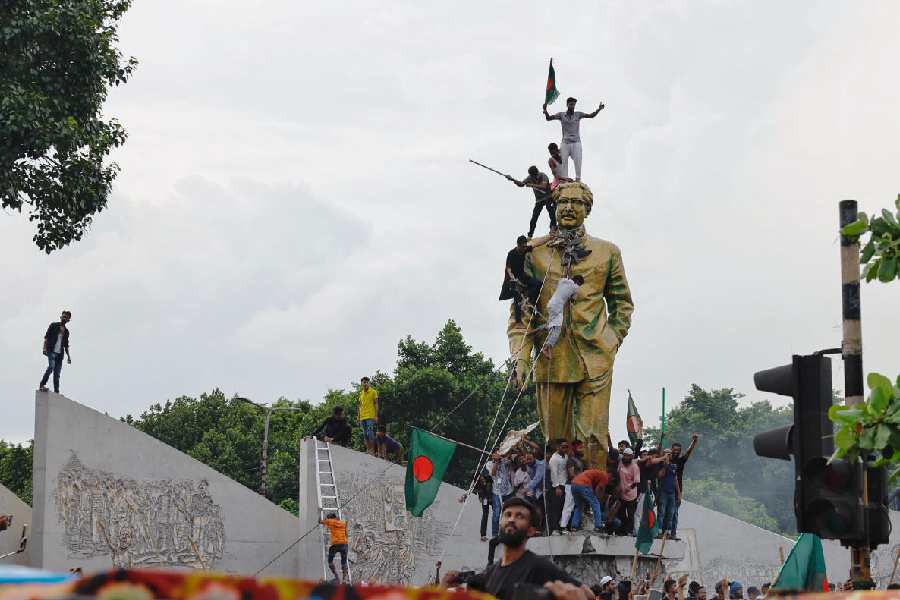It was around 11.50 on Friday night when my phone rang. It was a group call on WhatsApp from Bangladesh, featuring two unknown numbers.
“Dada, we need your help — will you?” asked one of the callers, a key player in Sheikh Hasina’s administration.
Amid the crisis in Bangladesh over the quota protests that had turned into a rebellion demanding Hasina’s resignation, I had been talking to multiple people in Dhaka over the last three weeks to gather information.
The request for “help” from an influential person stumped me for a moment before I requested him to explain what he meant.
He said the other person — a minister in Hasina’s cabinet — would explain what help I could offer.
“Boss, we are in a crisis. The government tried its best to deliver on the students’ demand for quota reforms, but still the protests are going on unabated,” the minister said.
“This entire protest has been taken over by the BNP and Jamaat-e-Islami. Some anti-government YouTubers, who are settled abroad, are inciting ordinary students through social media. And they are beating us hands down in the social media game,” he went on.
He was right. An apolitical and localised movement demanding reform of the government job quotas, which began on July 1, had metamorphosed into an uprising against the government primarily because of social media.
Tens of thousands of short reels of student protests, memes on Hasina and her senior ministers, and messages from student leaders had swamped all the Meta platforms like Facebook, WhatsApp and Instagram before the authorities shut down mobile Internet on July 17 and broadband services the day after.
“We need some experts who can help us counter the misinformation campaign on social media and help us take on our political rivals,” the minister said, the urgency in his voice unmistakable.
I could not offhand recollect any social media communication expert, but promised that I would get back if I found someone. The callers were busy and the communication didn’t last long.
After the call got disconnected, I kept thinking about the conversation I had had with two of the most influential people in the Hasina government. The biggest takeaway was that these men were on the verge of losing the game.
Hasina’s resignation on Monday — within 60 hours of that call — proved that the surmise was correct.
While the latest developments in Bangladesh may give the impression that the regime fell swiftly like a house of cards, the reality is that the government had been in a state of crisis for the last several years, having lost the support of the majority of the people.
Hasina had been in power since winning the general election of 2008 (after having had a five-year stint earlier, between 1996 and 2001). But the legitimacy of the subsequent elections had been in question, with the Opposition either boycotting them or participating half-heartedly.
While Hasina and the ruling Awami League claimed they enjoyed popular support, the absence of any Opposition worth the name in three consecutive general elections had caused the people to lose interest in the polls.
The economic woes faced by the ordinary people because of the government’s failure to check the price rise or create jobs compounded Hasina’s problems. The allegations of large-scale corruption by ruling party leaders — some of them from her cabinet — made the government even more unpopular. This pent-up anger added fuel to the protests that began when students first hit the streets demanding quota reforms.
The presence of ordinary people from all walks of life in the protests made it clear that running the government had become untenable for Hasina.
Friday night’s group call to me suggested that the government was intent on tackling the situation by countering the hate against the establishment through a smart social media campaign.
It was also banking on the armed forces to contain the uprising and prevent Monday’s “long march” to Dhaka, which finally led to Hasina’s fall.
In retrospect, there is little doubt that a well-functioning democratic structure in the country could have helped Hasina.
Had there been a vibrant Parliament with Opposition MPs asking her questions on national priorities, she would have been forced to address the bread-and-butter issues faced by the people.
She, however, chose to tread her own path, ever ready to swat away any questions about whether she was turning Bangladesh into an electoral autocracy.
She declared this year’s general election — in which her party bagged 74 per cent of the seats — as free and fair.
At a post-election news conference, this correspondent asked her a question on the state of democracy in the absence of an Opposition, as the last two parliaments were bereft of any major Opposition force.
“What do you want? Should I constitute an Opposition party?” she had replied.
The scenes from Dhaka on Monday proved that she did create an Opposition and that they were the people of Bangladesh, who have now ensured her exit.










